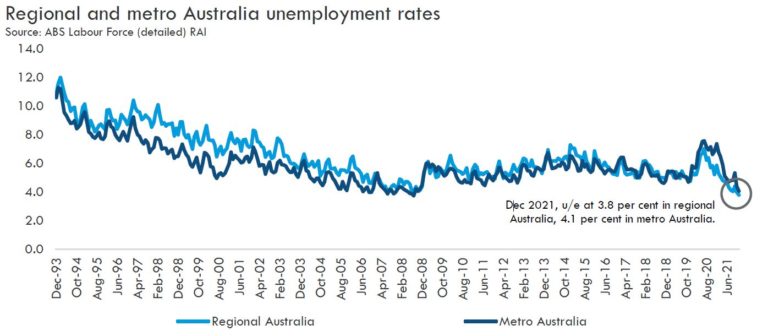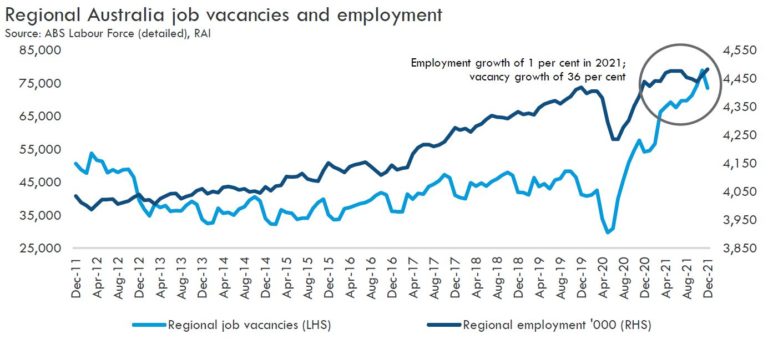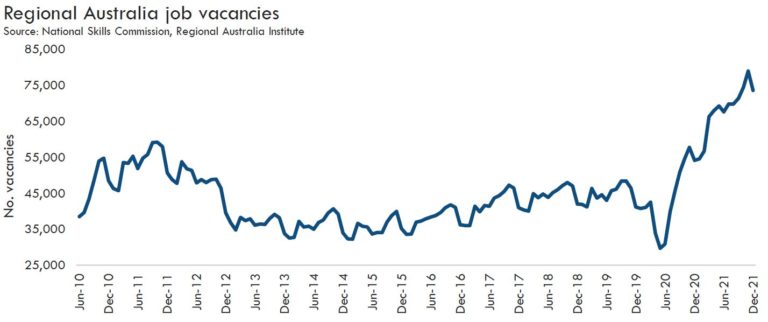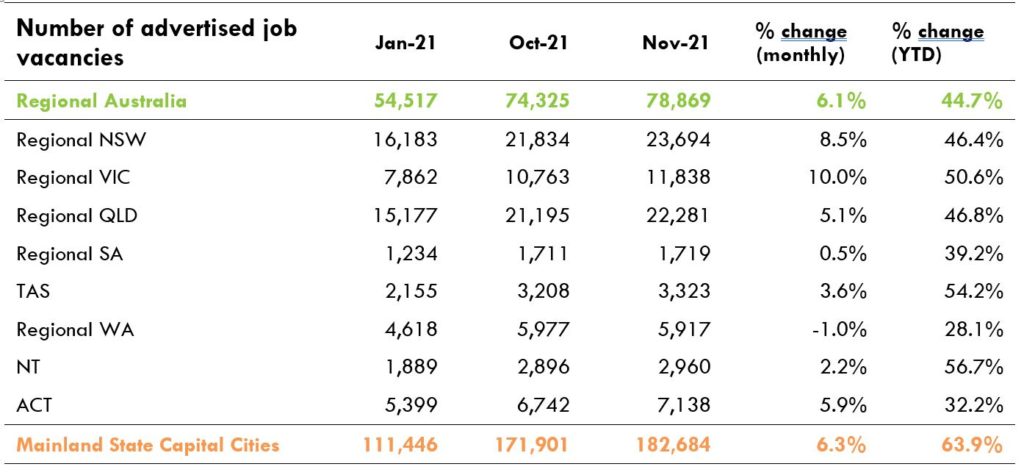By Chief Economist, Dr Kim Houghton, and Senior Economist, Diwa Hopkins
Download the December 2021 Report
REGIONAL LABOUR MARKET
As the Prime Minister unveiled the ambitious target of a national unemployment rate below 4 per cent — something that hasn’t been achieved since November 1974 — at his National Press Club address last week, regional Australia had already hit that target back in December last year when its unemployment rate fell to 3.8 per cent.

At the same time monthly regional job vacancies remained very strong — still well above the 70,000 mark, despite a 6.8 per cent decline during December. This December dip largely reflects seasonal hiring patterns, rather than any underlying easing up in regional labour demand — vacancies fall each December and generally in the order of 10 per cent.
With a full year of data now in, the picture that has emerged of regional labour markets is that they’re generally running at full employment and that labour shortages really started to bite in 2021. There is a clear pattern of ever-increasing job vacancies alongside roughly steady levels of employment throughout 2021.

Specifically, the number of people employed in regional Australia in December 2021 was just one per cent more than in December 2020, yet the number of job ads ballooned by 36 per cent.
Thankfully, we can look forward to 2022 with some optimism:
- International travel restrictions have eased, allowing some overseas skilled migration to resume (even if a return to pre-pandemic levels is a long way off)
- Domestic travel restrictions also eased, allowing for greater mobility in the domestic labour force, which is especially important for meeting all kinds of seasonal worker demand (whether in the tourism or agriculture industries, for example)
- New incentives have been offered to lower-skilled overseas migrants (international students and backpackers) to attract them back to Australia after a two-year hiatus.
This new environment in 2022 will be most beneficial for bringing about additional lower-skilled labour supply. Moreover, any remaining labour supply that can be squeezed from the ultra-low unemployment rate is also most likely to be lower or unskilled workers.
Yet regional Australia’s employers are demanding higher-skilled labour. Demand for professionals is strongest — accounting for one quarter of all vacancies in regional Australia in December 2021. Technical and trade worker vacancies were the next largest group, accounting for 16 per cent of all vacancies, followed by community and personal care roles at 13 per cent of all vacancies.
Additional policy measures that address education and training, as well as housing, are needed if labour supply (particularly skilled labour) is to meet labour demand in the regions.
In particular, what’s needed now is investment in the availability of quality post-school training and learning across regional Australia — as recommended by the National Regional, Rural and Remote Tertiary Education Strategy adopted by the Government in 2020. We are looking forward to working with newly appointed Regional Education Commissioner Fiona Nash in advancing this agenda.
Housing has also emerged as a key constraint on labour supply. Quite simply, regional Australia needs more homes of an appropriate mix for all of the additional workers it requires to meet employer demand. This is a key theme of RAI’s current research program. We’ll soon be releasing a discussion paper that sets out key areas of consideration for policy makers in how to bring about an adequate and appropriate mix of housing to regional Australia’s many and varied communities.
These measures will be important for regions in 2022 as competition for labour is shaping up to be very strong. Future capital-city lockdowns are looking far less likely and growth in job vacancies in the cities has already come roaring back — jumping by 58 per cent in 2021.
REGIONAL JOB VACANCIES
Regional job vacancies remained around the 70,000 mark in December 2021, despite a 6.8 per cent decline from the record number of vacancies in November. As highlighted above, this latest dip largely reflects seasonal hiring patterns rather than any underlying easing in labour demand.

Despite the various lockdowns that continued throughout 2021, demand for labour in regional Australia grew throughout the year. In December 2021 vacancies were 35.7 per cent higher than in December 2020. Across the states and territories, the strongest growth in regional vacancies over the year was in regional Victoria where the number of vacancies grew by 63 per cent. Moreover, this growth has been widespread across the state — all five of the state’s regions were among the top ten strongest-growing areas for job vacancies.
Growth in vacancies was next strongest in the Northern Territory (as it continues to recover from the protracted post-mining slump), where there was an annual increase of 46.7 per cent. Tasmania was next in line, with vacancies up 43.9 per cent.
Most regions recorded a seasonal dip in job vacancies in December, with two Victorian regions the exceptions:
- Gippsland with vacancies edging up by 0.6 per cent in December 2021 (2,801) compared with November (2,784)
- Bendigo & High Country with vacancies just about unchanged (3,686 compared with 3,681)
Regions with the smallest declines over the month:
- Geelong & Surf Coast down by 1.7 per cent (2,990 compared to 3,043)
- Ballarat & Central Highlands down by 2.0 per cent (1,183 compared with 1,207)
- Regional Northern Territory down by 2.9 per cent (820 compared with 844)
Four out of the five regions with the biggest jumps in vacancies over the year, December 2021 compared with December 2020, were Victorian:
- Geelong & Surf Coast up by 78 per cent
- Gippsland up by 65 per cent
- Ballarat & Central Highlands up by 63 per cent
- Bendigo & High Country up by 50 per cent
- Darwin up by 49 per cent

SOURCES The Internet Vacancy Index is updated monthly by the Department of Education Skills, Employment and Business (lmip.gov.au/default.aspx?LMIP/GainInsights/VacancyReport). The RAI has an interactive Regional Job Vacancy map of the data showing vacancies in 37 regions across Australia (regionalaustralia.org.au/home/regional-jobs-vacancy-map).